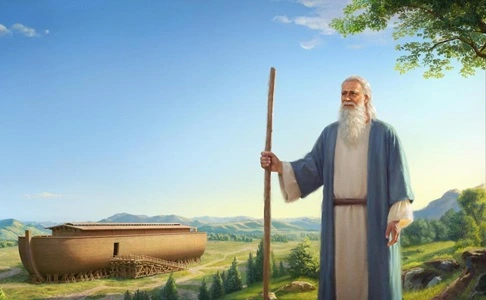Noah is one of the most recognizable figures in religious texts, particularly in the Judeo-Christian tradition. Known for his role in the story of the Great Flood and the Ark, Noah’s legacy has transcended cultures and continues to inspire countless interpretations in literature, art, and religion. Here are 32 interesting facts about Noah that explore his life, the significance of his story, and the enduring impact of this biblical character.

1. Biblical Origins
Noah’s story is primarily found in the Book of Genesis, chapters 6-9. He is described as a righteous man chosen by God to preserve life on Earth during a catastrophic flood.
2. The Meaning of Noah’s Name
The name Noah means “rest” or “comfort” in Hebrew. His father, Lamech, named him with the hope that Noah would bring comfort from the toil of work and the curse of the ground.
3. Lineage of Noah
Noah is the son of Lamech and the grandson of Methuselah, who is known for living 969 years, making him the longest-lived human figure recorded in the Bible.
4. The Ark’s Dimensions
According to Genesis 6:15, the Ark was to be made 300 cubits long, 50 cubits wide, and 30 cubits high. This roughly translates to about 450 feet long, 75 feet wide, and 45 feet high, making it one of the largest ships described in ancient texts.
5. A Family Man
Noah was married, and he had three sons: Shem, Ham, and Japheth. After the flood, these sons became the progenitors of the world’s nations.
6. The Covenant with God
After the floodwaters receded, God made a covenant with Noah, promising never to destroy the Earth by flood again. The rainbow is described as a sign of this covenant, symbolizing God’s promise.
7. The Great Flood
The Great Flood, which Noah and his family survived, is said to have lasted for 40 days and 40 nights (Genesis 7:12). The floodwaters covered the Earth and destroyed all life except for those aboard the Ark.
8. Animals on the Ark
Noah was instructed to bring pairs of every kind of animal onto the Ark, ensuring their survival. According to Genesis 6:19-20, he took one male and one female of each species, though some interpretations suggest that he brought seven pairs of clean animals for sacrifice.
9. Noah’s Age
Noah was 600 years old when the flood began (Genesis 7:6). This extreme longevity is a common theme in early biblical narratives, where many figures lived for several centuries.
10. Noah as a Farmer
After the flood, Noah became a farmer and is noted for planting a vineyard (Genesis 9:20). This highlights his return to agriculture and cultivation after the chaotic events of the flood.
11. The Story of Noah’s Drunkenness
One of the more controversial aspects of Noah’s story is his drunkenness after drinking wine from the vineyard he planted. This incident led to a significant event involving his son Ham, which resulted in a curse upon Ham’s descendants (Genesis 9:21-27).
12. Shem, Ham, and Japheth’s Roles
Noah’s sons played crucial roles in the post-flood world. Shem is often associated with the Semitic peoples, Ham is linked to African nations, and Japheth is traditionally seen as the ancestor of the Indo-European peoples.
13. Noah’s Righteousness
In the context of Genesis, Noah is described as a righteous man who walked with God. His character serves as a stark contrast to the wickedness of humanity at that time, which is cited as the reason for the flood.
14. The Ark’s Construction
The Ark’s construction took a significant amount of time, with some interpretations suggesting it took Noah over 100 years to build. This extensive period reflects Noah’s faith and obedience to God’s command, despite the ridicule he likely faced from others.
15. Noah and the Animal Kingdom
Noah is often depicted as a protector of the animals, showing compassion and responsibility in caring for them during their time on the Ark. This theme resonates with modern discussions about conservation and environmental stewardship.
16. Noah’s Influence in Different Cultures
The story of Noah has parallels in various cultures and religions, including the Epic of Gilgamesh from ancient Mesopotamia, which features a character named Utnapishtim, who survives a great flood.
17. Literary and Artistic Representations
Noah’s story has inspired countless works of art, literature, and music throughout history. From paintings by Renaissance artists to modern films and children’s books, Noah’s Ark remains a popular subject.
18. Noah’s Ark as a Symbol of Salvation
In Christian theology, Noah’s Ark is often seen as a symbol of salvation and refuge, representing the hope of redemption for humanity. This theme is frequently explored in sermons and theological discussions.
19. Theological Interpretations
Various religious traditions interpret Noah’s story differently. For example, in Judaism, Noah is considered a righteous figure, while some Christian interpretations emphasize the moral lessons derived from his actions and God’s judgment.
20. The Ark Encounter
In modern times, the Ark Encounter in Williamstown, Kentucky, is a popular attraction that features a life-size replica of Noah’s Ark. This attraction aims to educate visitors about the biblical account and the historical context of the story.
21. The Flood’s Duration and Impact
The floodwaters are said to have covered the Earth to a depth of 15 cubits (about 22.5 feet) above the highest mountains (Genesis 7:20). This detail emphasizes the totality of the flood and its devastating impact on the world.
22. Noah’s Legacy in the World Today
Noah’s legacy endures in contemporary discussions about faith, environmental responsibility, and community. His story serves as a reminder of the importance of stewardship and the interconnectedness of life on Earth.
23. Covenant Significance
The rainbow as a sign of God’s covenant with Noah has become a powerful symbol of hope and promise across various cultures. It represents not only the specific covenant with Noah but also broader themes of hope in the face of adversity.
24. Noah in the New Testament
Noah is referenced in the New Testament, notably in Matthew 24:37-39, where Jesus compares the days of Noah to the days of His return. This reference emphasizes the importance of vigilance and preparedness.
25. The Role of Faith
Noah’s unwavering faith in God despite societal disbelief is a central theme of his story. His willingness to act on God’s instructions is often cited as an example of true faith in action.
26. Global Flood Stories
Many cultures around the world have flood myths that share similarities with Noah’s story. These narratives often reflect cultural values and beliefs about divine intervention and human morality.
27. Noah as a Model of Obedience
Noah’s obedience to God is a critical aspect of his character. His willingness to follow God’s instructions without question serves as an important lesson about faith and trust.
28. The Ark’s Design
While the exact design of Noah’s Ark is not detailed in the Bible, the dimensions provided have led to various interpretations of its construction. This has sparked interest among architects, historians, and theologians, who speculate about its feasibility and the types of materials that would have been used.
29. Noah’s Place in History
Noah is often viewed as a pivotal figure in the history of humanity, as his actions are believed to have contributed to the preservation of life on Earth. His story serves as a reminder of the potential for renewal and the importance of moral choices.
30. Enduring Popularity
The story of Noah and the Ark remains a popular theme in children’s literature, toys, and educational programs. This enduring interest highlights the story’s universal themes of hope, family, and resilience.
31. Modern Interpretations
In recent years, there have been various modern interpretations of Noah’s story, including films like “Noah” (2014), which presents a dramatic retelling of the biblical narrative. These adaptations often explore the themes of faith, responsibility, and the consequences of human actions.
32. Noah’s Ark in Popular Culture
Noah’s Ark has been referenced and reimagined in countless forms of popular culture, from cartoons and comics to theater and music. This widespread recognition reflects the story’s lasting impact and its relevance in discussions about faith, morality, and humanity.
Noah’s story is one that has transcended time and culture, leaving a profound legacy that continues to resonate with people around the world. Each of these 32 facts showcases the richness of his narrative, emphasizing themes of faith, obedience, and renewal. Whether viewed through the lens of religion, history, or popular culture, Noah’s legacy remains a powerful reminder of the importance of choices, stewardship, and the enduring spirit of hope.


